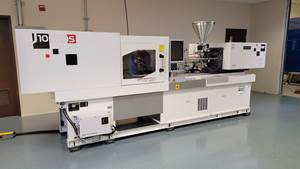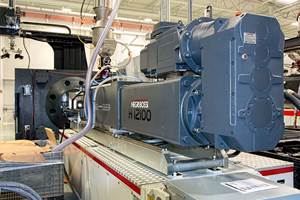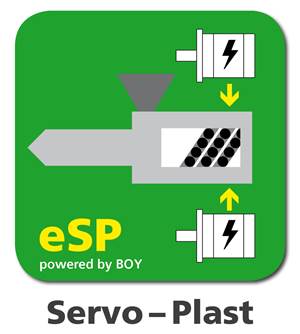New Injection Machine Safety Standards in MI Could Have National Consequences
In a bid to have the state’s safety guidelines better reflect the national standard, the Michigan Occupational Safety and Health Administration (MIOSHA) has adopted new machine safety guidelines that have sparked more questions than answers for molders and machinery suppliers.
Effective Jan. 1, 2017 operators of horizontal injection molding machines in Michigan will be required to comply with full lockout/tagout (LO/TO) requirements if there is the potential for harmful exposure to hazardous energy sources during maintenance and servicing activities.
Previously, mold changes through either the front or rear gate of a horizontal injection molding machine were allowed as long as the machine had a functional mechanical safety plus two independent interlocks on the operator’s gate, as well as an emergency or other stop that would shut off the motors that activate the clamp.
MIOSHA has now changed the rule—Part 62 Plastic Molding Safety Standard R408.16234—so that it meets OSHA’s General Industry Safety Standard Part 85 “The Control of Hazardous Energy Sources”. Specifically, starting in the new year, molders are instructed to phase out procedures that allow for either the front or rear gates of a horizontal press to be locked in the open position during mold changes. MIOSHA has recognized that the Part 85 Lockout standard might not be possible on some machines without shutting down a press’s heating system.
MIOSHA has stated that there are exceptions to the LO/TO requirements. Specifically, these include maintaining or servicing presses if there is machine guarding that’s deemed capable of eliminating exposure to “hazardous energy.”
David Palmer, SPI’s director of industry affairs—equipment council, noted that MIOSHA deems routine mold or die changes to be maintenance and servicing activity. According to OSHA CPL 02-00-147, setting up is “any work performed to prepare a machine or equipment to perform its normal production operation.” Setting up is not considered utilization of a machine or equipment and is classified as servicing and/or maintenance, rather than normal production operations.
Minor services, in the eyes of MIOSHA, would include things like lubricating, cleaning or un-jamming equipment. Barrels and hot runner manifolds would also be considered a hazardous energy source requiring personal protective equipment and signage.
Machinery suppliers have pointed out to MIOSHA that during a tool change molders want to maintain heat and have access to a powered-up control, and the agency has recognized that, noting that “it would be allowable to use a separate energy isolating device that can be locked out during the die changing process for a motor, pump or other equipment…while leaving power on to the heating elements and computer controls.”
Industry Response
SPI: The Plastics Industry Trade Association held a meeting in Chicago on August 3 with members to discuss the rule change, with a follow up conference call on Nov. 17. In an email, Palmer noted that the association had been working directly with MIOSHA to reverse the changes to Part 62. It has also reached out to Michigan molders asking for information it could use to lobby on their behalf.
MIOSHA noted in an Oct. 3 email from the Michigan Department of Licensing and Regulatory Affairs that it had mailed letters to approximately 1000 companies in the state classified under the NAICS 326 code (Plastics and Rubber Manufacturing) giving notice of the change.
MIOSHA’s Consultation Education and Training (CET) Division also scheduled six information sessions to “ensure awareness of the updated standard and answer any questions employers may have.” Held from mid-October through December 7, these sessions took place in Canton, Kentwood, and Lansing, Mich. At the time the email was sent, the sessions on Oct. 18 and Nov. 1, held in Canton and Kentwood, respectively, where completely booked, while a Dec. 7 event in Lansing only had three seats left.
A question in the email announcing the sessions reflected how potentially sweeping the changes could be, asking:
“Could this change affect you? It might if you have horizontal plastic injection mold machines and perform mold changes.”
Related Content
Medical Grade Injection Molding Machine Line is Cleanroom Ready
JSW America says the J100ADS-110U medical grade molding machine has been optimized to prevent dust, rust and other contaminants.
Read MoreWord Games: What’s a ‘Hybrid’?
Any molder will tell you there’s a difference in working with electric vs. hydraulic drives. Servohydraulic is still hydraulic; a hybrid machine is something different. Imprecise use of terms causes needless confusion.
Read MoreUpdated Control, Cooling Water Distribution, Electromechanical Ejector and Injection
NPE2024: Boy’s U.S. subsidiary marks its 50th anniversary in Orlando with six machines and U.S. intros for the Procan ALPHA 6 control, and hybrid ejectors and injection units.
Read MoreSlimmer All-Electric Press Debuts
A slimmed-down version of Engel’s all-electric, e-mac injection molding machine is among eight displays, which also include LSR micromolding, quick mold changes and a cube mold.
Read MoreRead Next
How Polymer Melts in Single-Screw Extruders
Understanding how polymer melts in a single-screw extruder could help you optimize your screw design to eliminate defect-causing solid polymer fragments.
Read MoreUnderstanding Melting in Single-Screw Extruders
You can better visualize the melting process by “flipping” the observation point so that the barrel appears to be turning clockwise around a stationary screw.
Read MoreTroubleshooting Screw and Barrel Wear in Extrusion
Extruder screws and barrels will wear over time. If you are seeing a reduction in specific rate and higher discharge temperatures, wear is the likely culprit.
Read More

























